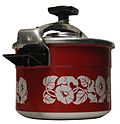Pressure cooker
Pressure Cooker is a cooking appliance used in kitchens worldwide. It operates on the principle of steam pressure, a process where water or broth is heated in a sealed pot (the pressure cooker), creating steam that cooks food quickly.
History[edit]
The first pressure cooker was invented by French physicist Denis Papin in the 17th century. He called his invention the "Digester," and it was primarily used for scientific experiments. The modern pressure cooker, as we know it today, was developed in the 20th century and has become a common kitchen appliance.
Design and Operation[edit]
A pressure cooker consists of a pot with a locking lid that creates a seal, and a valve system to control the pressure. When heat is applied, the liquid inside the pot forms steam, which raises the pressure within the pot. This high pressure allows the temperature inside the pot to rise above the normal boiling point of water, which speeds up the cooking process.
Uses[edit]
Pressure cookers are used for a variety of cooking tasks. They are particularly useful for cooking foods that normally take a long time to prepare, such as beans, stews, and braised meats. They are also used in canning to kill bacteria and preserve food.
Safety[edit]
Modern pressure cookers have safety features to prevent accidents, such as a locking lid that cannot be opened while there is pressure inside the pot. However, it is important to follow the manufacturer's instructions to ensure safe use.
See Also[edit]

This article is a cooking appliance stub. You can help WikiMD by expanding it!
-
Pressure cooker
-
Pressure cooker manufactured by Georg Gutbrod, Stuttgart, about 1864
-
Super Cocotte decor SEB-MGR Lyon
-
WMF Schnelldrucktopf 4.5 Liter Perfect Ultra
-
Instant Pot DUO60 pressure cooker
-
Dampfdruckkurve
-
Pressure cooker oval lid
-
Aluminum pressure cooker kazan from Afghanistan
Ad. Transform your life with W8MD's Budget GLP-1 injections from $75


W8MD offers a medical weight loss program to lose weight in Philadelphia. Our physician-supervised medical weight loss provides:
- Weight loss injections in NYC (generic and brand names):
- Zepbound / Mounjaro, Wegovy / Ozempic, Saxenda
- Most insurances accepted or discounted self-pay rates. We will obtain insurance prior authorizations if needed.
- Generic GLP1 weight loss injections from $75 for the starting dose.
- Also offer prescription weight loss medications including Phentermine, Qsymia, Diethylpropion, Contrave etc.
NYC weight loss doctor appointmentsNYC weight loss doctor appointments
Start your NYC weight loss journey today at our NYC medical weight loss and Philadelphia medical weight loss clinics.
- Call 718-946-5500 to lose weight in NYC or for medical weight loss in Philadelphia 215-676-2334.
- Tags:NYC medical weight loss, Philadelphia lose weight Zepbound NYC, Budget GLP1 weight loss injections, Wegovy Philadelphia, Wegovy NYC, Philadelphia medical weight loss, Brookly weight loss and Wegovy NYC
|
WikiMD's Wellness Encyclopedia |
| Let Food Be Thy Medicine Medicine Thy Food - Hippocrates |
Medical Disclaimer: WikiMD is not a substitute for professional medical advice. The information on WikiMD is provided as an information resource only, may be incorrect, outdated or misleading, and is not to be used or relied on for any diagnostic or treatment purposes. Please consult your health care provider before making any healthcare decisions or for guidance about a specific medical condition. WikiMD expressly disclaims responsibility, and shall have no liability, for any damages, loss, injury, or liability whatsoever suffered as a result of your reliance on the information contained in this site. By visiting this site you agree to the foregoing terms and conditions, which may from time to time be changed or supplemented by WikiMD. If you do not agree to the foregoing terms and conditions, you should not enter or use this site. See full disclaimer.
Credits:Most images are courtesy of Wikimedia commons, and templates, categories Wikipedia, licensed under CC BY SA or similar.
Translate this page: - East Asian
中文,
日本,
한국어,
South Asian
हिन्दी,
தமிழ்,
తెలుగు,
Urdu,
ಕನ್ನಡ,
Southeast Asian
Indonesian,
Vietnamese,
Thai,
မြန်မာဘာသာ,
বাংলা
European
español,
Deutsch,
français,
Greek,
português do Brasil,
polski,
română,
русский,
Nederlands,
norsk,
svenska,
suomi,
Italian
Middle Eastern & African
عربى,
Turkish,
Persian,
Hebrew,
Afrikaans,
isiZulu,
Kiswahili,
Other
Bulgarian,
Hungarian,
Czech,
Swedish,
മലയാളം,
मराठी,
ਪੰਜਾਬੀ,
ગુજરાતી,
Portuguese,
Ukrainian







